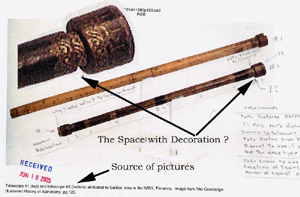|
Important issues
comparing the original 2428 Galileo telescope with
the Adler Cipriani replica telescope.
Deciding on sliding tubes for the
lens Both the Cipriani replica
telescopes 2427 and 2428 have sliding tubes carrying both the eyepiece
and objective that slip into the main telescope body.
The question is did the original #2428 have them too? This was
not completely resolved with our visit to IMSS. From the
literature we found extra decorated space between the
objective housing and the end of the barrel. This
appears in figure 9 below, suggests that at least there
was a sliding lens holder for the objective which could
have been used for extending it out for longer focal
length objectives. Using this objective adjustable
feature for focusing would have been troublesome it is
too far to reach. Therefore an adjustment also at the
eyepiece end would also have been sensible. essentially
The photos of the original telescope during restoration
suggests that the protruding staves were part of the
sliding mechanism at both ends and not simple cardboard
tubes as has been suggested. It appears that the tubular
stave construction was used throughout . Also the 1704
inventory listed the telescope as coming in two pieces
for lengthening it.
We still wonder about the little
Marble paper covered eyepiece holder which would make
three length changing elements even though it has very
little adjustment, perhaps 8 or so millimeters hardly
the 7 cm. needed to focus on objects 30 meters away. We
believe that there is enough circumstantial evidence
suggesting that the Florence telescope has these
telescoping lens sections as well, but they are stuck
inside the telescope IMSS photos show the staves
sticking out from ends of the main tube. We therefore
include telescoping tubes in our 2428 replica.
IMSS photos of the staves sticking out of the body of
original telescope gave us a good measurement for the
outer diameter of the sliding tubes but not their length
The length of the
objective tube we were able to establish to an accuracy
of about 1 centimeter. To get this length we used our
measurements of the expanded portion of the main
telescope tube at the objective end which is expanded
down the main barrel to accommodate the sliding tube.
For the eyepiece tube we
chose to use the length of 27 cm as was used in
Cipriani replica at the Adler Planetarium . If
Information surfaces to the contrary it can be cut back
to 12 cm where the decorations on this tube start.
We also looked into the
information to be gained for an estimate of sliding tube
dimensions from the Cipriani replicas. We looked into
two of his replicas one at the Science Museum south
Kensington London reported by Baxandall in our
ref 1. The second from our measurements of a Cipriani
replica at Alders Planetarium
Baxandall in his
drawings do not agree with each other to within 10% nor
do they replicate the outer dimensions of the original
where the diameters are different as much as 10% which
is a factor of 10 greater than our goal for accuracy.
Also strangely the Cipriani telescope
does not have a red marble paper covered eyepiece which
would have been altogether out of stile with the rest of
the original instrument but has a decorated disk framing
the eyepiece down in the container similar to the
objective. A detailed examination of his replicas shows
a number of strong differences between them and the
orginal ranging from dimensional differences to art work
differences It almost like Cipriani tried to incorporate
improvements and changes to make it easier to build.
We also took detailed photos of the decorations covering
the telescoping sections of the Adler instrument. They
are a combinations of the deco's on the out side but
patterned and scaled differently. We did not incorporate
any of Cipriani inconsistencies in dimensions and We
chose not to make them out of cardboard as Baxandall
reports that Cipriani did for the replica for the
science museum London. We stayed with the stave
construction which is consistent with the rest of the
original telescope.
The visit Adler to get detailed pictures and measurement
of the art deco on their number 2 replica was also very
valuable. Although there are some issues in scaling and
details in shape of the Cipriani instrument that are not
true to the original telescope we were able to use then
to get a better prospective of the finer detail always
referring back to the original to make the final
decision for this project.
 |
ref 1, Replicas of Two Galileo
Telescopes by David Baxandall, 1924 Trans Opt. Soc. 25
141-144
Figure 9 Image from The Cambridge
Illustrated History of Astronomy pg 123
All photos
and written material are by Jim & Rhoda Morris unless
noted otherwise. Free personal and educational use and
reproduction is encouraged--- Acknowledgment is
appreciated; all commercial rights are reserved
SciTechAntiques.com HOME PAGE

Copyright
04/18/2007 Jim & Rhoda Morris |